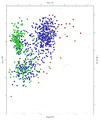Exoplanet_Mass-Radius_Scatter_Super-Earth.png

Summary
| Description Exoplanet Mass-Radius Scatter Super-Earth.png |
English:
Scatter plot of super-Earth characteristics in context showing the mass,
m
, and radius,
r
, for
compared with those of along with detected through 2014-04-19. Scales indicate (log 10 of) planetary mass, m , expressed as Earth masses (bottom) and Jupiter masses (top); planetary radius, r , expressed in Earth radii (left) and Jupiter radii (right); and counts n (gray ticks on right). References lines are provided for approximate mass-radius relationships [1] for selected planetary compositions: Exoplanet data is from the Open Exoplanet Catalogue, [2] version 4945b99 . The figure shows all planets up to 10 M J (omitting 59 more massive planets), and transiting planets up to 18 R E (omitting an additional 17 with m ≤ 10 M J but r > 18 R E ). PSR B1257+12 b (with m < 10 -4 M J ), lies off to the left of the graph, and is also omitted. Important note: This figure is intended to serve as a catalog of generally accepted candidate exoplanets using the distribution of some of their basic properties related to detection. No attempt has been made to characterize the degree of confidence (which varies widely) in the existence of a given planet or its properties. Nor is any attempt made to convey systematic errors associated with a particular method. In particular, the indicated mass, m , for an exoplanet characterized using radial velocity is the minimum mass (so that the actual distribution of masses for non-transiting planets may be shifted and "smeared" significantly to the right).
|
| Date | |
| Source | Own work |
| Author | Aldaron , a.k.a. Aldaron |
| Other versions |
Related graphs
|
Licensing
| Public domain Public domain false false |
|
|
I, the copyright holder of this work, release this work into the
public domain
. This applies worldwide.
In some countries this may not be legally possible; if so: I grant anyone the right to use this work for any purpose , without any conditions, unless such conditions are required by law. |


